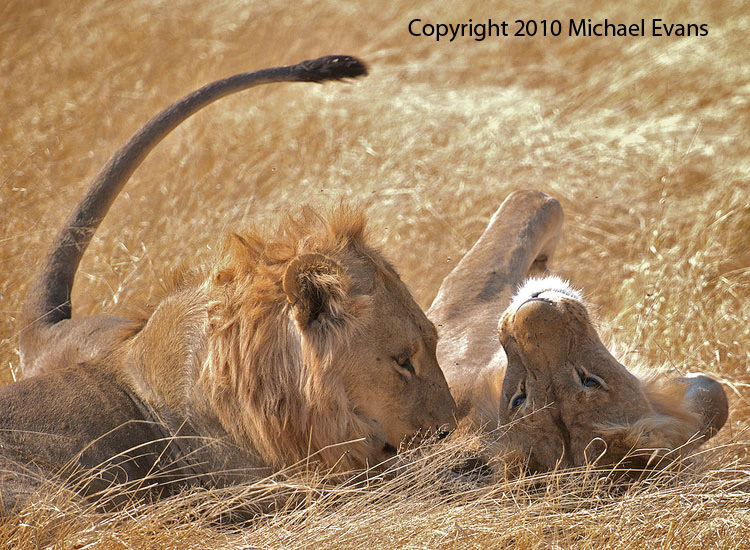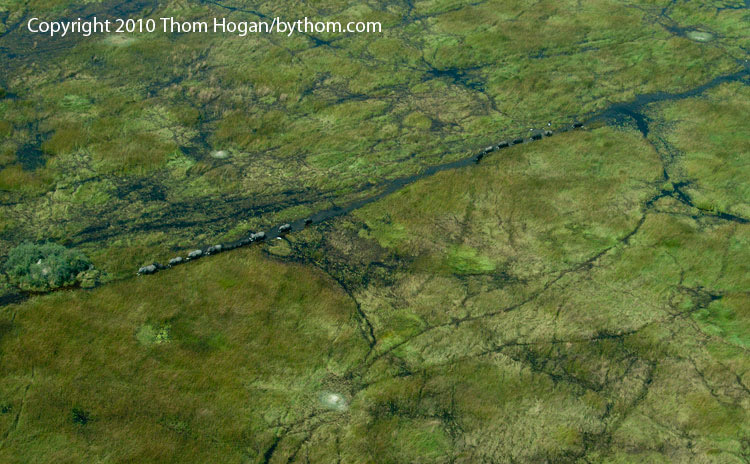Sept 8—So here's the scene: the tent I'm sharing with Tony is about twenty meters from our guide Adam's tent. Last night no more than twenty meters beyond Adam's tent lay a huge, sated male lion. His belly—the lion's, not Adam's—was so distended from his latest meal he could hardly walk. His stomach almost reached the ground when standing.
Within an hour of lights out last night, Tony started conjuring up the most impressive snoring storm I've heard from him in the years we've been working together. Tony would let out a great snore. The lion would let out a territorial challenge roar. Tony would snore. The lion would roar. This continued for at least twenty minutes as Tony faced off the lion in a clear territorial dispute. Surprisingly, the lion blinked first. Suddenly the next roar was from a little further away. Eventually, the lion just moved off, not sure what it was that was claiming his terrain so boldly. Of course, at that point, I still had one lion to contend with and he was still in my tent raising a ruckus.
So this morning, Adam bestowed upon Tony a new nickname: Mufasa. King of the Jungle. I think I have to commemorate that some way memorable, don't you? I'm thinking of getting a small metal plaque engraved with the nickname and having it mounted on Tony's tripod. That way everyone that encounters him knows not to be in the tent next to his...
Ribbing aside—and Tony's good natured about it, so no harsh emails folks—we still had some things to do today. I asked everyone at breakfast what they most wanted to see. Leopard. Amazingly, the wish was granted within seconds of leaving camp this morning, as about 100 meters beyond where the lion was last night was a leopard in a tree.
The leopard spooked when the first vehicle approached, coming down out of the tree and off into the brush. Probably because she knew she was in lion territory and was a little nervous about all the roaring going on the previous evening. But once she got out into a field and onto a termite mound, she calmed down enough for us to approach. Better still, she posed herself perfectly on the sunlit side of the mound and curled her tail up in a cute way that everyone was instantly attracted to photographing. (Curled tail is not a "cute" trait at all; curled means "agitated.")

We stayed as long as we dared, but we had a plane to catch, so reluctantly--and very reluctantly for the three cat aficionados in the last vehicle--we drove on towards the airstrip. Only to find eight lions posing very nicely and even performing some nice pride interaction behavior. Once again out came the big lenses, and we worked the scene for as long as we dared.


As I wrote earlier: we had a plane to catch, so the rest of the drive was a Ferrari safari to the airstrip, where our two chartered planes showed up shortly after arriving (we were right on time, the planes were on Africa Time). Our destination now was Camp Okavango, a little island oasis in the middle of the water-filled part of the delta. We kept the plane low, and the parade of animals as we passed overhead was impressive. But most impressive was a long line of elephants we saw wandering through one of the reed patches towards water.
From the air you get the full impact of the Okavango. Wet and greener to the North Northwest, dryer and browner to the Southeast. Threads of animals tracks everywhere. Small herds of animals here and there. Just an amazing assortment of wild going on below us. Including two herds of elephants moving up one of the water channels:

I was in the front of the plane with a wide lens, so had an odd angle trying to shoot back under the wing; I had to have the pilot pivot the plane slightly to get this shot. But Vince in the back of the plane with a longer lens had a good shot of them as we first crossed the channel:

Earlier in the blog I mentioned that we try to be as friendly to the land as possible, but that the animals do a fair amount of roughing up of the land. From the air in the delta you see evidence of that everywhere:

Yes, those are all animal tracks. In fact, many of what passes for roads in this part of Africa started as animal tracks. Ecosystems are strange things. It's incorrect to believe that an ecosystem has a perfect natural state. Ecosystems are living things in and of themselves. Seeds get dislodged, water channels move due to animal paths, everything is in a constant state of flux. You can't "preserve" places like this, you can only try not to change the impacts of or influence the natural changes going on. Ten years ago, this little strip of land looked different. Ten years from now, it will look still different. But that should be a "natural" different, not a human-caused one.
The flight was over far too soon. Because the airstrip at Camp Okavango has been below water most of the year so far, we couldn't land our Cessna Caravan there and instead landed at the nearest other grass strip that hadn't been flooded. Next, we boarded our third safari transportation mode of the day: delta boats. While the distance from the strip to the island where Camp O is located isn't large, the way is through ever-twisting tendrils of stream running between reeds swaying in the wind. Crocs on the banks. Talapi in the water. A gentle flow of the water pushing us southward.

At times, the banks felt like they were closing in on us. Heaven knows what a paranoid claustrophic person on Lariam would think of the ever constricting waterways we used, but it was a very different experience from the Land Cruisers, and everyone had a big smile on their face when we reached Camp O.
But the day was not done. After the requisite afternoon high tea we were off in two person canoes to be poled through the nearby delta. Much macro mahem ensued as little frogs, dragonflies, water lillies, and more came into our viewfinders from only a few inches above the water and a few inches from the subject. To wit, here's my shot:

And here's how close Tony when he was trying to get the same shot:

At the end of a couple of hours wandering through the sedge, we gathered for a group picture, and came onto the camp's barely dry airstrip, where we had our sundowner (and all the photographers did more shooting than drinking).

Another long Botswana day, and one with so many little twists and turns for the students that everyone had a big grin on their face by the end of the day.
For the record: four forms of transportation and everything from 600mm shots at distance to teeny macro work at canoe side. Now that's a day's worth of photography.
